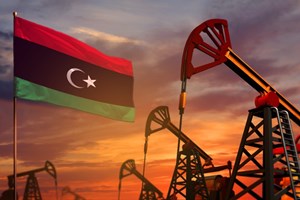Oil gains as Libya shuts its largest oil field amid protests
(Bloomberg) — Oil rose with the shutdown of Libya’s biggest oil field in an already under-supplied market overshadowing signals that China’s lockdowns are weighing on its economic growth.
Brent crude futures rose above $113 a barrel for the first time since late March. West Texas Intermediate traded around $108. Global markets face further interruptions to oil supplies after demonstrations against Libya’s Prime Minister Abdul Hamid Dbeibah shut down Sharara, the country’s biggest oil field. Protesters also forced two Libyan ports to stop loading, with output halted at the El Feel field.
Earlier, prices fell as Chinese economic data signaled bearish news for the market. China reported its biggest decline in consumer spending and worst unemployment rate since the first months of the pandemic, adding another threat to global growth.
Oil rallied above $100 this year as the war in Ukraine disrupted an already-tight market, with some traders shunning Russian crude. The surge spurred the U.S. and allies to announce the release of millions of barrels from strategic reserves to quell inflationary pressures. Nonetheless, global supplies remain tight with OPEC and its partners declining to raise the pace at which they’re restoring output shuttered during the pandemic.
Russia’s Deputy Prime Minister Alexander Novak said last week that if more nations banned Russian energy flows, prices may “significantly exceed” historic highs. The U.S. and U.K. have moved to bar crude from the country after Moscow’s invasion of Ukraine, and there’s pressure for the European Union to follow.
“The market is still making up its mind about how much Russian oil may be kicked out of the market,” said Matt Stanley, a trader and broker with Star Fuels in Dubai. “That’s keeping Brent at about $110 a barrel.”
|
Prices: |
|
In a weekend phone call, Russian President Vladimir Putin and Saudi Crown Prince Mohammed bin Salman gave a “positive assessment” of their efforts to stabilize the oil market, suggesting that no change in production policy is likely. The two nations lead the alliance that groups the Organization of Petroleum Exporting Countries and its partners, known as OPEC+.
Crude markets remain in backwardation, a bullish pattern that reflects tight supply. Brent’s prompt spread -- the gap between its two nearest contracts -- was more than $1.14 a barrel in backwardation, up from 21 cents last week.
Oil’s surge this year has been part of a wider advance in energy commodities that’s seen prices extend gains even as the outlook for global economic growth dims. On Monday, U.S. natural gas prices hit the highest level in more than 13 years as robust demand tests drillers’ ability to expand supplies.



